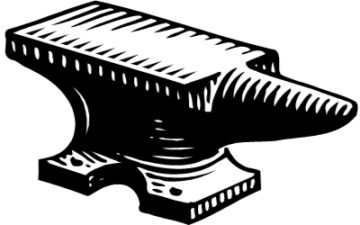I have uncovered a liminal framework—a way of looking at our current Fiscal/Debt dilemma—that could help us frame a seemingly insoluble dilemma of how to reduce national debt while continuing to create jobs. Let’s consider the blacksmith, his hammer, and his anvil.
 As late as the early 20th century, the blacksmith was a familiar figure in any community:
As late as the early 20th century, the blacksmith was a familiar figure in any community:
In a typical American town in 1900, one would expect to find livery stables, feed stores, wagon shops, blacksmith shops, horse corrals, horse traders, and horse trainers in about the same ratio that we now find auto dealers, repair shops, parts stores, driving instructors, and fueling stations. This shows how much the blacksmith was a part of the local economy.
I can imagine children gathering in fascination to watch the sweaty man dance his hammer. The rough red-white hot iron bar would magically yield to the hammer, to become anything from a nail to a wheel rim to a wrought iron fence filigree.
The children would gaze in wonder with every ringing blow of the hammer as it hit the glowing iron: what would it become?
Few would pay much attention to the boring anvil. It’s heavy, ugly and just sits there. Without the anvil, there would be no singing, no poetry of motion, no useful implement created. Observers of any era love the motion of the hammer and the result of its blows.
This liminal picture—a frame around the beauty of a healthy economy—could help us make sense of how folks frame the deficit and the glacial speed of bipartisan movement toward addressing the imminent sequester and its budget cuts.
We are currently fixated on Congress as the seemingly immobile arm of the blacksmith—hampering Adam Smith’s “invisible hand” from Neoclassical economics—hovering above the sequester issue. Our attention turns to the glowing iron on the anvil—the magical compromise to the sequester. We fear not only that the iron rapidly cools but that even the coals of the forge itself—the fuel of our American Dream—may even extinguish itself: Congress is once again about to hit its head on the approaching debt ceiling.
 The anvil? Without the current extraordinary measures like quantitative easing and the Fed taking on higher percentages of risky debt (CMOs, TARP), unemployment would be even higher and we would likely not enjoy the current stock market highs.
The anvil? Without the current extraordinary measures like quantitative easing and the Fed taking on higher percentages of risky debt (CMOs, TARP), unemployment would be even higher and we would likely not enjoy the current stock market highs.
There appears to be no way forward. We appear to be caught between the frozen arm of fiscal compromises and the anvil of our burgeoning federal debt and debt ceiling.
Lest you think we can continue to ignore the impact of our growing debt, consider the ways many Americans will be hurt. This recent Syntrinsic Investment Counsel article so eloquently summarized just a few of the many arenas impacted by our national debt:
Public Pension Benefits
Most Americans rely on Social Security or comparable municipal pension plans for most if not all of their retirement income. …Health Care Accessibility
…The resulting financially driven limits on health care are most acutely felt by those with the least financial resources because they cannot afford to go outside the system to get the services they need or want.Food Security
Despite our country’s food relief efforts, Feeding America claims that nearly one in six Americans (16.7%) regularly misses meals due to lack of affordability….Food inflation—whether spurred by increased demand or by the devaluation of the dollar—hits hardest those for whom food is the largest percentage of discretionary income.Housing Assistance
The Department of Housing and Urban Development reports that over 8.7 million Americans rely on public housing or subsidized housing (Section 8). …International Aid
Through USAID, America grants $50 billion per year in direct aid to other countries. Some aid is strictly strategic, but a meaningful amount provides food and disaster relief, combats AIDS, and supports civil society efforts in sub-Saharan Africa, Latin America, and other areas that rely on America’s generosity to mitigate local economic and political weakness. This year alone, the Federal Reserve’s Quantitative Easing claims about $85 billion per month or over $1 trillion in 2013, dwarfing in size and impact the $50 billion per year in aid.
Blows from the fiscal policy hammer strike us where we live, as well as those we can get our arms around.
This additional item in the Syntrinsic commentary particularly caught my attention:
Jobs
According to the US Treasury the annual cost of servicing America’s debt represents 2-3% of national GDP and that cost will rise, draining our economy much in the way a parasite sucks nutrition from its host’s bloodstream. In this sluggish economy, those with the weakest qualifications will be those who struggle the most to find viable work. The job market is becoming more global and more competitive and a weak economy always hurts those at the bottom of the ladder worst of all, in particular because they have the least cushion with which to start.
I propose that we respond to other parts of this picture rather than fixating on just the paralyzed arm of the blacksmith.
I have chosen Good Neighbor Garage as the place where I can do my part to keep families in the Denver Metro Area on wheels to work, school, places of worship.
This week’s Toolkit will encourage you to keep pursuing your part.
Next week, I’ll examine a second hidden aspect of the federal debt anvil—it’s the “deep magic” of what the Fed and Treasury can do to influence the monetary policy within the anvil. The debt anvil appears solid but, if the Modern Monetary Theorists are correct, it is not what it seems to be. Stay tuned next week to find out why!
Toolkit:
1. Which fiscal area do you care about most?
a. How might you take action to make a difference?
b. If you are already involved how is your involvement affecting one of the issues listed above? Pat yourself on the back!
2. Do you have a bipartisan forum within which to engage in healthy dialogue?
Let me know if you are interested in being part of such a discussion, either virtually or in person.



